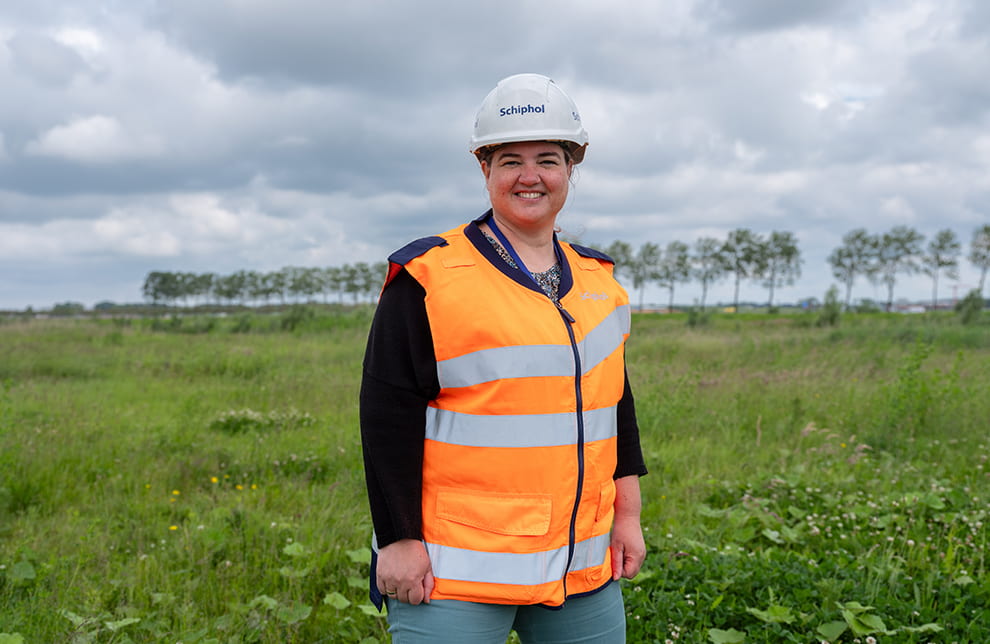‘This cleaning method is the best option for the clayey Schiphol soil’: Interview Annemarie van Biemen

What does a day in the life of a soil specialist look like?
No two days are the same. My main task is to advise projects about how to deal with soil when carrying out digging activities. That could be for a 20-metre cable for a charging station, or for the construction of a new terminal or baggage basement involving many tonnes of soil. I have contact with our project managers, the main contractors, the independent research institute that conducts the soil surveys if too little is known about soil quality, and the Environment Agency.
How do you think the rumours surrounding the origins of PFAS came about?
Much was unclear about PFAS in the beginning. That can quickly lead to rumours. I’ve heard all sorts; that it’s in road salt and in the fluid we use to deice aircraft wings. That’s not the case, as studies have shown. It was, however, in firefighting foam. The type of firefighting foam that contained PFAS was prescribed for, among other things, liquid fires at airports. These regulations have now been changed and only PFAS-free firefighting foam has been used since 2020.
How do you determine whether PFAS-containing soil is dangerous for people and the environment?
Several steps are involved. We enlist the help of research institute Terrascan to do this. They test the soil, sediment, ground water and surface water. There are three possible categories for the results. First, we do not find PFAS contamination in the soil. Second, we find PFAS but at such low levels that it does not pose a danger to people and environment. This soil can be reused straight away. Third, we find PFAS in the soil above the limit for reuse. We take this soil to a temporary storage site where it is wrapped in protective material. That still does not mean that this soil is a potential risk to humans and the environment. Those limits are a lot higher. The National Institute for Public Health and the Environment (RIVM) and the Public Health Service (GGD) have derived standards for this against which research results are tested.
To what extent does PFAS-contaminated soil at Schiphol pose a potential risk to people?
In order to actually speak of a risk, there must also be exposure. That doesn’t happen. We cover all soil that we do not reuse at the top and bottom with sturdy protective material. We then place clean soil on top of that. This prevents exposure and leakage into ground and surface water. However, one batch does have a higher PFAS content than the risk limit value for industry on public green spaces. That is approximately 0.4% of the total soil.
There are photos of torn covering on the internet. Is that material strong enough?
That's an internet phenomenon where old photos resurface and are compared to today's reality. We discovered that the covering we used to use was not suitable for long-term storage and would tear due to certain weather influences. We always repaired that immediately. Studies have shown that those tears did not lead to contamination. We have been using the new strong covering for five years now and there have not been any tears. That is also evident from inspections.
In addition, there have been quite a few changes since the soil was ‘not reusable’. That's important to us because then we know whether or not to cover it. Many of the pictures of torn material on the internet involve soil that is now considered reusable. We are not going to repackage soil that we are now allowed to reuse in the strongest material. This would actually be bad for the environment, as extra covering means more waste and CO2 emissions.
Can you imagine that local residents are worried about their health?
Of course. PFAS can be damaging to both the environment and health. I understand that you’d want to keep PFAS as far away as possible from your loved ones. However, the risk of exposure is non-existent. We prevent potential health risks thanks to all the necessary measures we take.
As a local resident you could also say: ‘Schiphol, just take that soil away and be rid of it’.
You could take it to another location, but that means more transport movements and you are just shifting the problem. Moreover, this was not possible for a long time. We were told that the market would have a solution for PFAS in the soil within five years. I am very happy that we did not wait for that and approached companies and market parties ourselves to look for a solution together to clean the soil. After a long search through all kinds of organisations and different methods, we decided on DEME's soil treatment facility. They have proven that their cleaning method best suits our clayey Schiphol soil.
How do you see the future of PFAS at Schiphol?
I can’t wait until we get a permit for the facility. As soon as it has been built, we can clean all soil we have in temporary storage within approximately three years. That will be a huge step for not only Schiphol, but also the Netherlands. It means making much more PFAS-containing soil, that we can currently only store, suitable for sustainable reuse.